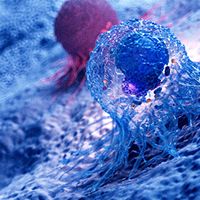Article
Press Release
Targeted Chemotherapy Helps Cure Some Inoperable Tumors
Author(s):
Physicians at Cedars-Sinai Cancer are using a unique chemotherapy delivery system that offers hope to colorectal cancer patients whose disease has spread and who now have inoperable liver tumors.
Cristina Ferrone, MD

Physicians at Cedars-Sinai Cancer are using a unique chemotherapy delivery system that offers hope to colorectal cancer patients whose disease has spread and who now have inoperable liver tumors. Cedars-Sinai is one of the few centers in the area to offer the therapy, called hepatic artery infusion (HAI) pump chemotherapy.
“Many of these patients are not candidates for curative surgery and we now have a meaningful option for treating them,” said Cristina Ferrone, MD, chair of the Department of Surgery at Cedars-Sinai and a specialist in the care of patients with complex hepato-pancreato-biliary disorders. “This therapy has been shown to extend both life and quality of life.”
Colorectal cancer is the fourth-leading cause of cancer-related death in the U.S. In as many as 25% of patients diagnosed with the disease, the cancer spreads to the liver, where it can be difficult to treat. However, more than half of patients receiving hepatic artery infusion pump therapy go on to receive curative surgery, studies have shown.
Surgical oncologist Alexandra Gangi, MD, director of the Gastrointestinal Tumor Program at Cedars-Sinai Cancer and associate professor of Surgery at Cedars-Sinai, sat down with the Cedars-Sinai Newsroom to explain this lifesaving therapy.
How do the pumps work?
We surgically place the pump underneath the skin, outside of the abdominal cavity, and it is attached to tubing that enters the abdominal cavity and goes into the gastroduodenal artery. That artery feeds into the hepatic artery, which supplies blood to the liver. During surgery, we block blood flow from the gastroduodenal artery from going into portions of the small intestine so that the therapy flows only to the liver.
The pump has a soft center, allowing its internal reservoir to be filled through the skin via a syringe. After surgery, the patient comes in every two weeks and we refill the pump, which then allows the chemotherapy drug to flow directly into the liver via the arterial supply.
Which patients are likely to benefit from hepatic artery infusion pump therapy?
This therapy is designed for patients, based on the distribution of the metastatic disease (where are the tumors and how many), for whom curative surgery is not an option at the time of diagnosis. The best we had been able to offer these patients was lifelong chemotherapy that had potential systemic toxicities, and that never quite reduced their tumor size to the point that we could surgically remove it. This therapy offers an additional option for liver-directed therapy that can potentially make patients candidates for surgery by specifically targeting the liver disease.
What are the advantages of the hepatic artery infusion pump over traditional chemotherapy delivery?
A majority of these tumors derive their blood supply from the hepatic arterial system, and delivering chemotherapy to the tumors through the hepatic arterial system allows us to give higher doses of specific chemotherapeutic agents without exposing the patient to their systemic toxicities. Data shows that up to 60% of appropriately selected patients receiving hepatic artery infusion pump chemotherapy were then able to receive curative surgery. Patients can often continue receiving systemic chemotherapy in combination with hepatic artery infusion pump chemotherapy.
Are hepatic artery infusion pumps used to treat other types of liver cancer?
Some patients with cholangiocarcinoma are currently treated with HAI pumps, but this is not yet standard of care. Colon cancer is the second most common cancer, and colon cancer that has metastasized to the liver affects a significant number of patients. And we have seen good outcomes with those patients. Other types of cancers that metastasize to the liver are significantly more challenging to treat, and thus far, we don't think this therapy will benefit those patients.
Is this a new therapy?
Hepatic artery infusion pumps have actually been around for about 25 to 30 years, but until quite recently only a few medical centers were using them. But more and more centers are realizing that this therapy can truly benefit patients, and it is becoming more widely available.









